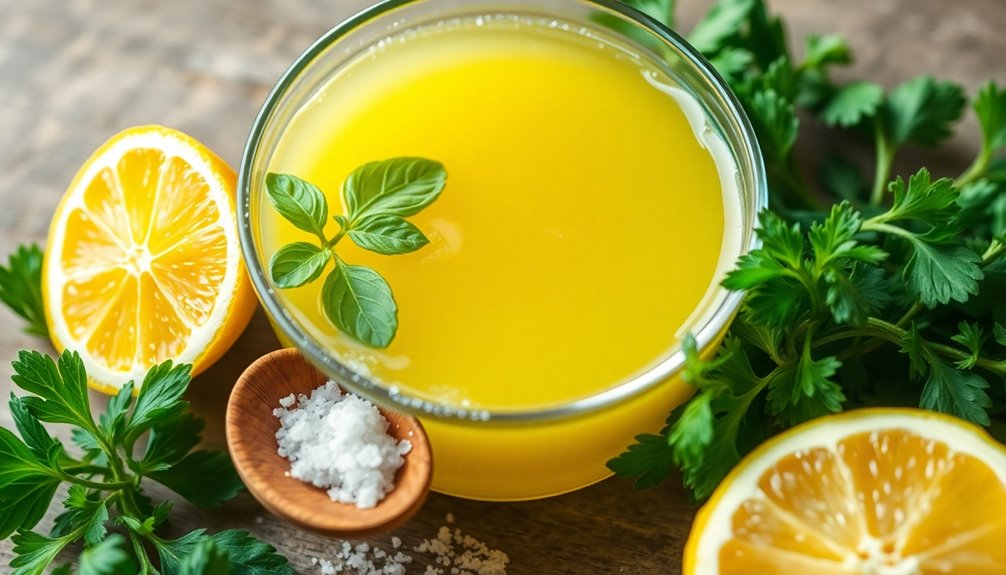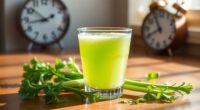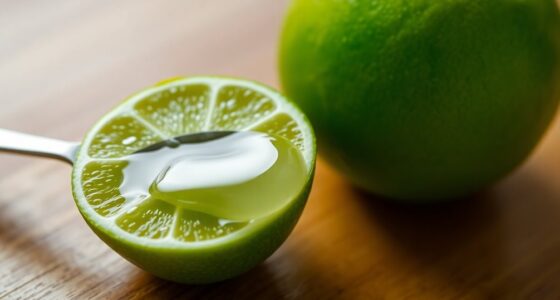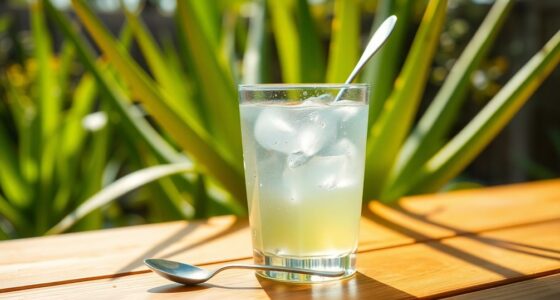If you've added too much lemon juice, don't worry—there are quick fixes! Start by incorporating neutral ingredients like cooked potatoes or white beans to absorb the acidity. You can also add more olive oil or a small amount of sugar to mellow the tartness. Diluting with broth or water helps as well. Just remember to taste and adjust seasoning as you go. Curious about more tips? There are plenty of ways to balance flavors effectively!
Key Takeaways
- Incorporate neutral ingredients like cooked potatoes or white beans to absorb acidity and mellow flavors.
- Add a few tablespoons of olive oil to counteract acidity and smooth out lemon flavors.
- Introduce a teaspoon of sugar or a drizzle of honey to offset the tartness of the lemon.
- Dilute the dish with more liquid, such as broth or water, to lessen the concentration of lemon juice.
- Taste and adjust by adding salt or herbs gradually to enhance the overall flavor balance.
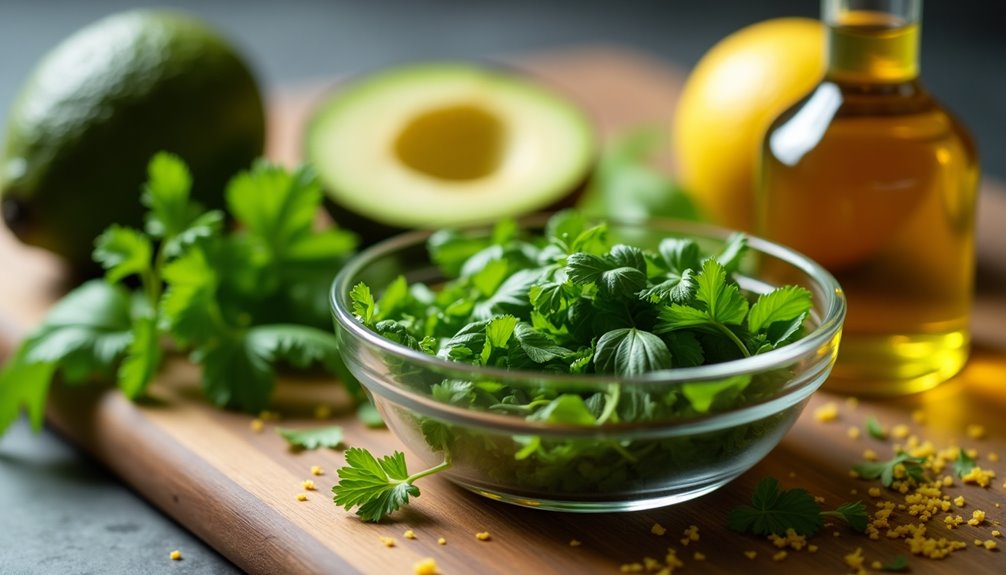
If you've added too much lemon juice to your dish, don't worry—there are simple ways to balance the flavors. First, keep in mind that lemon flavor can be quite strong, and if you find yourself with a dish that's too sour, you can take a few steps to bring it back in line. The key is to counteract that overpowering lemon taste and create a more harmonious balance of flavors.
One effective approach is to incorporate a neutral ingredient, like cooked potatoes or white beans. These ingredients can absorb some of the excessive acidity, helping to mellow out the dish's overall flavor. Just add them in and give everything a stir, tasting as you go to ensure you're achieving that different flavor profile you're aiming for. This method works particularly well in soups and stews where you have a bit more room to play with ingredients.
Another option is to add more olive oil. The fat in the oil can counteract the acidity of the lemon, smoothing out the flavors in your dish. Drizzling in a little more olive oil can help tone down the sharpness of the lemon juice. Keep an eye on the proportions, though, since you don't want to turn your dish into an oily mess. Just a few tablespoons can make a significant difference in balancing out that strong lemon taste.
You might also consider sweetening things up a bit. Adding a small amount of sugar or honey can effectively offset the tartness of the lemon without drastically changing the dish's flavor profile. Just start with a teaspoon of sugar or a drizzle of honey, and mix it in thoroughly before tasting. You'll be surprised how a little sweetness can make a big difference in calming down that sharp lemon flavor.
If your dish allows for it, another excellent technique is to dilute the lemon taste by adding more liquid. This could be broth, water, or even a complementary sauce. By increasing the overall volume of your dish, you’ll lessen the concentration of that much lemon juice, making it more palatable. Just remember to adjust the seasoning accordingly, as diluting might require a little extra salt or herbs to maintain flavor. Additionally, you can experiment with other ingredients that naturally complement the lemon flavor, such as olive oil or creamy elements like yogurt or sour cream. These additions not only help to soften the acidity but also contribute richness that can enhance the overall dish. When considering how to balance lemon juice flavor, don’t hesitate to taste as you go; adjusting gradually will allow you to achieve the perfect equilibrium without overwhelming the other flavors.
Lastly, don't forget to taste and adjust as you go. Gradually adding ingredients and tasting after each addition is key to achieving a balanced flavor. You might find that a pinch of salt or a sprinkle of additional herbs can help round out the dish, making it more enjoyable.
With these simple strategies, you can turn a too-lemony disaster into a delicious triumph, allowing the bright, citrusy notes to enhance your dish without overwhelming it.
Frequently Asked Questions
What if I Added Too Much Lemon Juice?
If you've added too much lemon juice, you might notice an overpowering tartness in your dish.
Start by draining any excess liquid to reduce the acidity.
Then, consider incorporating fats like olive oil or cheese to balance the flavors.
Adding neutral ingredients like cooked potatoes or rice can help absorb some of that sourness.
Finally, a pinch of sugar or honey can sweeten it up, so taste as you go to adjust accordingly.
What Can Neutralise Lemon Juice?
To neutralize lemon juice, you can add sweet ingredients like sugar or honey to balance the sourness.
Dairy products, such as cream or yogurt, help mellow the acidity, while fats like olive oil or butter coat your palate and reduce the sour taste.
Additionally, incorporating neutral foods like cooked potatoes or white rice can absorb excess acidity.
Finally, consider adding herbs or spices that complement your dish to enhance flavor complexity.
What Cuts the Bitterness of Lemon?
To cut the bitterness of lemon, you can add a pinch of sugar or honey to bring in some sweetness.
Creamy ingredients like yogurt or sour cream work wonders, too, softening that sharpness.
Incorporating fats, such as olive oil or butter, helps coat your palate, reducing the bitter taste.
If you're cooking, try briefly heating the lemon juice to mellow its flavor.
Lastly, coconut milk or avocado can create a creamy base that balances everything beautifully.
How to Counteract Too Much Lemon on Reddit?
When life hands you a dish that's too zesty, don't fret! You can easily bring harmony back to your flavors.
To counteract that overpowering lemon, try adding a splash of olive oil or a sprinkle of sugar. Creamy elements like yogurt can work wonders, too.
If you've got some cooked potatoes or rice, toss them in; they'll absorb that excess zing.
Taste as you go, and soon you'll have a balanced masterpiece!
Conclusion
In the grand culinary tapestry, a splash of lemon juice can elevate a dish or, if overused, overshadow it. But don’t fret; you can easily restore balance. Whether you dilute with broth, enhance with sweetness, or add creamy elements, remember that even the most seasoned chefs face a culinary misstep now and then. Just as Daedalus crafted wings of wax, you too can soar above this setback with a touch of creativity and finesse. To further enhance your culinary creations, consider experimenting with fresh ingredients that can complement the flavors at play. For instance, if you’re struggling to balance acidity, you might decide to make celery juice in blender for a refreshing, mild option that brings a crispness without overpowering your dish. Ultimately, cooking is a journey of discovery, where each misstep is merely a new opportunity to learn and innovate in the kitchen.
Cindy thoroughly researches juicing trends, techniques, and recipes to provide readers with practical advice and inspiration. Her writing style is accessible, engaging, and designed to make complex concepts easy to understand. Cindy’s dedication to promoting the advantages of juicing shines through her work, empowering readers to make positive changes in their lives through the simple act of juicing.

